








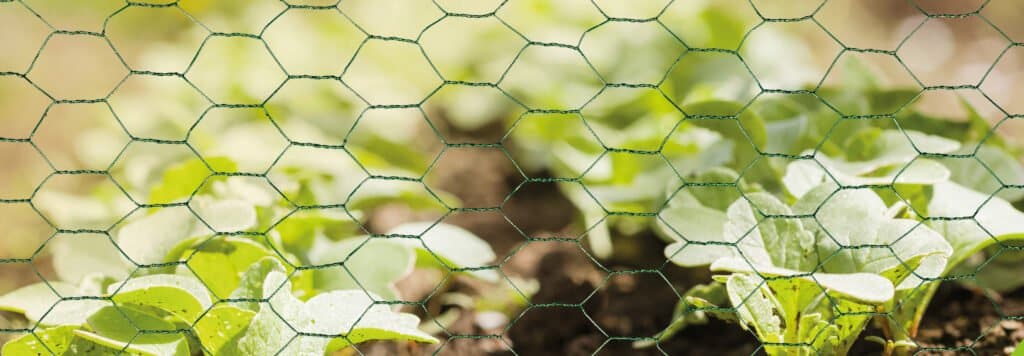
Chicken mesh is a versatile and flexible material that is used for a variety of purposes in the UK.
PVC chicken wire mesh is used to create enclosures for chickens, ducks, and other small animals, as well as to protect gardens and crops from animals such as rabbits and deer. It can also be used to support climbing plants and to create decorative fencing.
The green colour of the PVC coating allows the mesh to blend in with its surroundings, making it a popular choice for garden and landscaping applications. Additionally, the plastic coating helps to prevent the wire from scratching or otherwise damaging surfaces.
But how is it made? Is it right for your project? How do you dispose of it when you are done?
This article aims to answer these questions and many more….
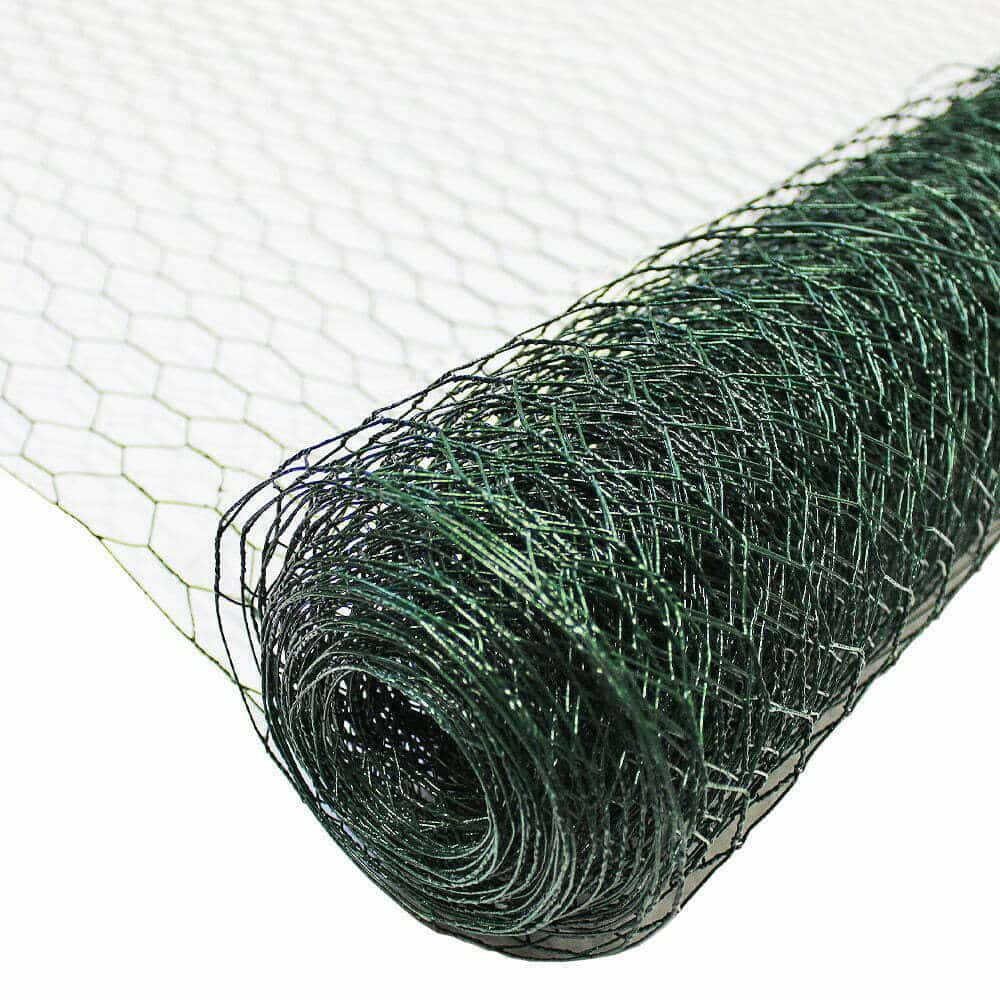
Green PVC chicken wire mesh is made by taking a length of galvanized steel wire and running it through a coating process. The wire is first cleaned and then coated with a layer of green PVC (polyvinyl chloride) plastic.
The coating process usually involves heating the wire and then immersing it in a tank of liquid PVC. The liquid PVC adheres to the wire, creating a smooth and uniform coating. The coated wire is then passed through an oven to cure the plastic coating, which ensures that it is durable and long-lasting.
Once the PVC coating is cured, the wire can be woven into the characteristic hexagonal mesh pattern of chicken wire. The finished product is then rolled up into large spools for easy storage and transportation.
The size of the mesh for a chicken run depends on several factors, including the size and type of the birds you are housing, the location of the run, and the potential predators in the area. Generally, the mesh size for a chicken run should be small enough to prevent predators from entering, while still allowing for adequate ventilation and sunlight.
For standard-sized chickens, a mesh size of 1 inch (2.54 cm) is usually recommended. This size is large enough to allow for good air circulation and visibility, but small enough to keep out most predators, such as raccoons and foxes. For bantam chickens or smaller birds, a smaller mesh size of 1/2 inch (1.27 cm) may be necessary to prevent predators from entering.
In addition to the size of the mesh, it’s important to ensure that the wire is strong enough to withstand potential damage from predators, such as chewing or scratching. A wire gauge of at least 19 or 20 is recommended for chicken runs, as this is sturdy enough to provide protection and durability.
For more information on building as chicken coop then check out the useful article that our team recently produced: how to build a chicken coop. This is an essential deep dive into the subject, and it will probably answer all the questions that you may have.
13mm green PVC chicken mesh is also known as 1/2 inch mesh, as it has a mesh size of 1/2 inch or 13mm.
This type of mesh is commonly used to create enclosures for chickens, ducks, and other small animals, as well as to protect gardens and crops from animals such as rabbits and deer. The 13mm size is suitable for smaller birds, such as bantams, as well as for protecting smaller plants.
13mm galvanised steel chicken mesh is another super popular option. 13mm mesh is not too common on the market, so this is a very popular item in our range.
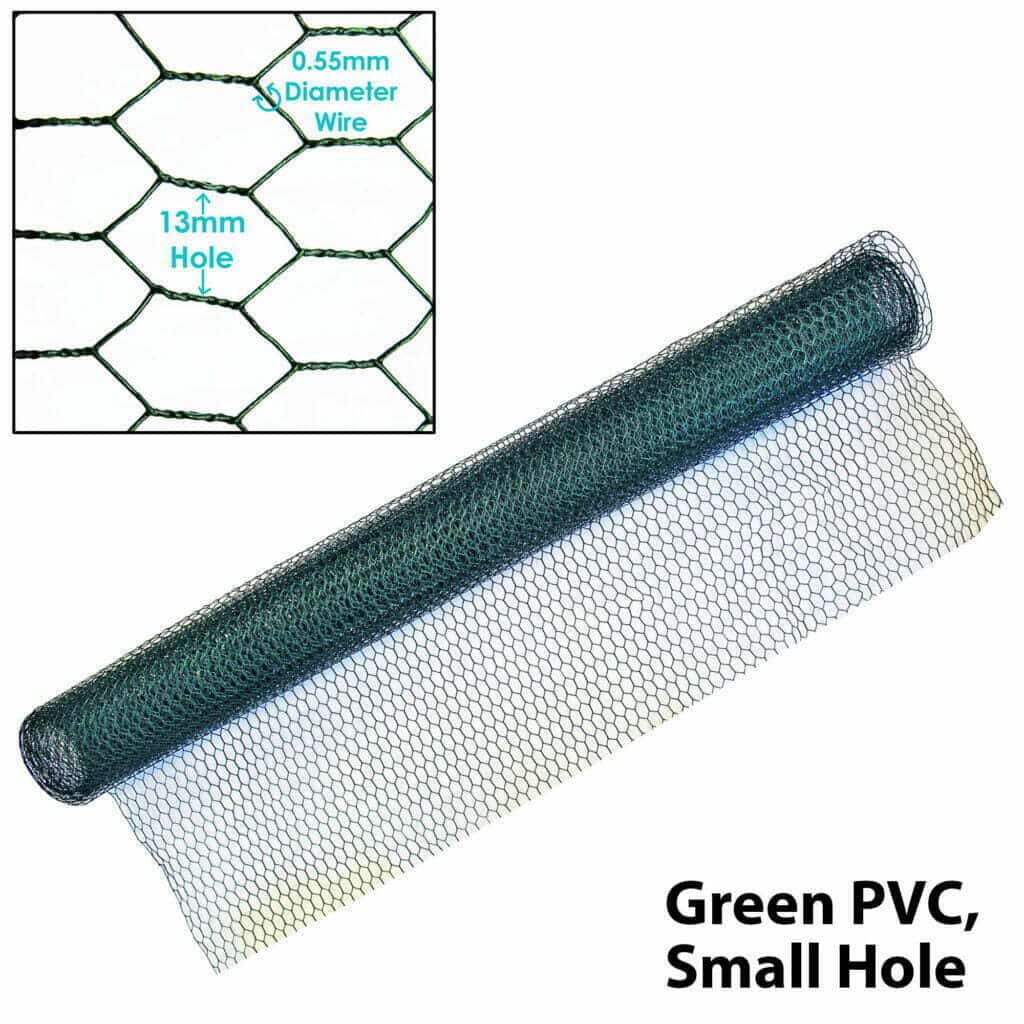
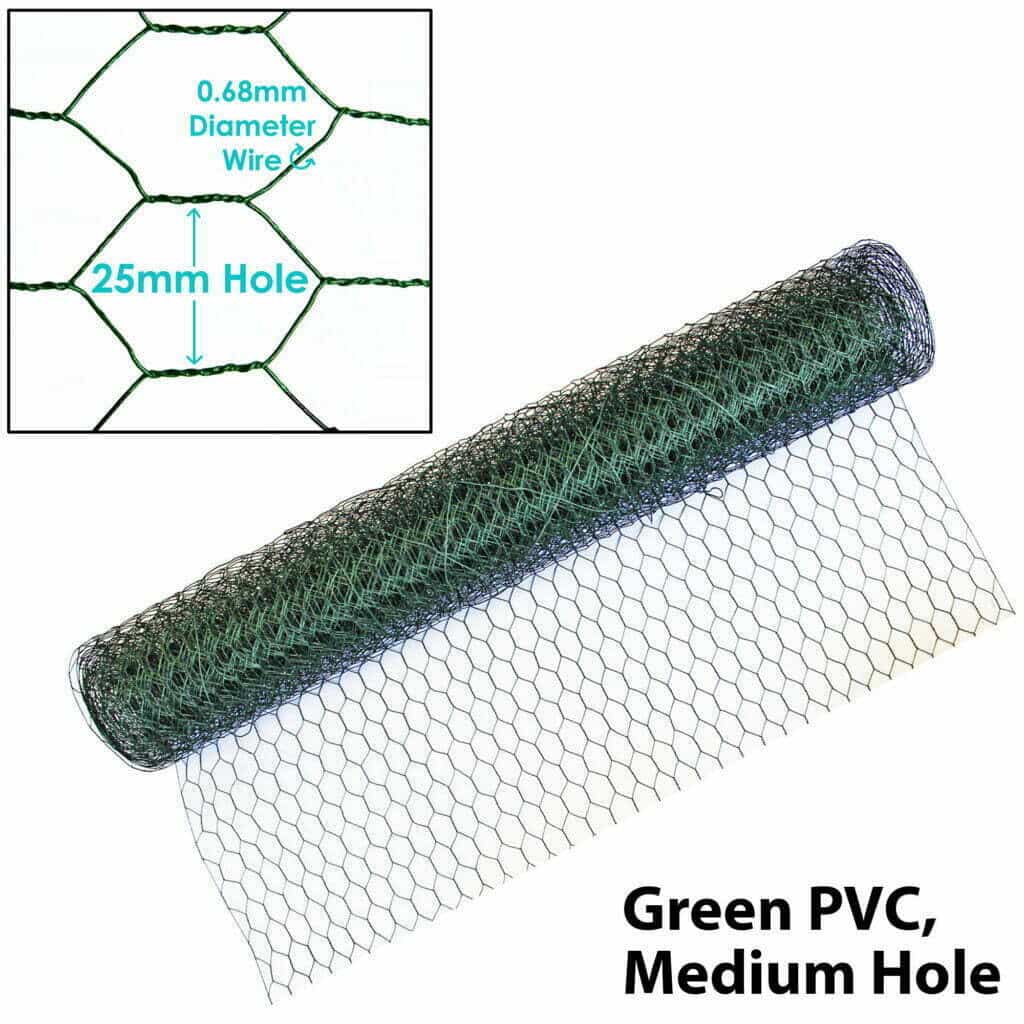
25mm green PVC chicken wire is also known as 1 inch mesh, as it has a mesh size of 1 inch or 25mm.
The 25mm size is suitable for larger birds and for providing more airflow to the enclosure.
We also offer 25mm chicken wire in galvanised steel if that suits yours needs better
50mm green chicken wire is a type of wire mesh commonly used in gardening and landscaping applications. This type of wire mesh is also known as 2 inch mesh, as it has a mesh size of 2 inches or 50mm.
This mesh size is really popular as it provides support for plants, creates decorative fencing, and protects gardens and landscaping from animals such as rabbits and deer.
Yes, we also offer this in galvanised steel if you prefer.
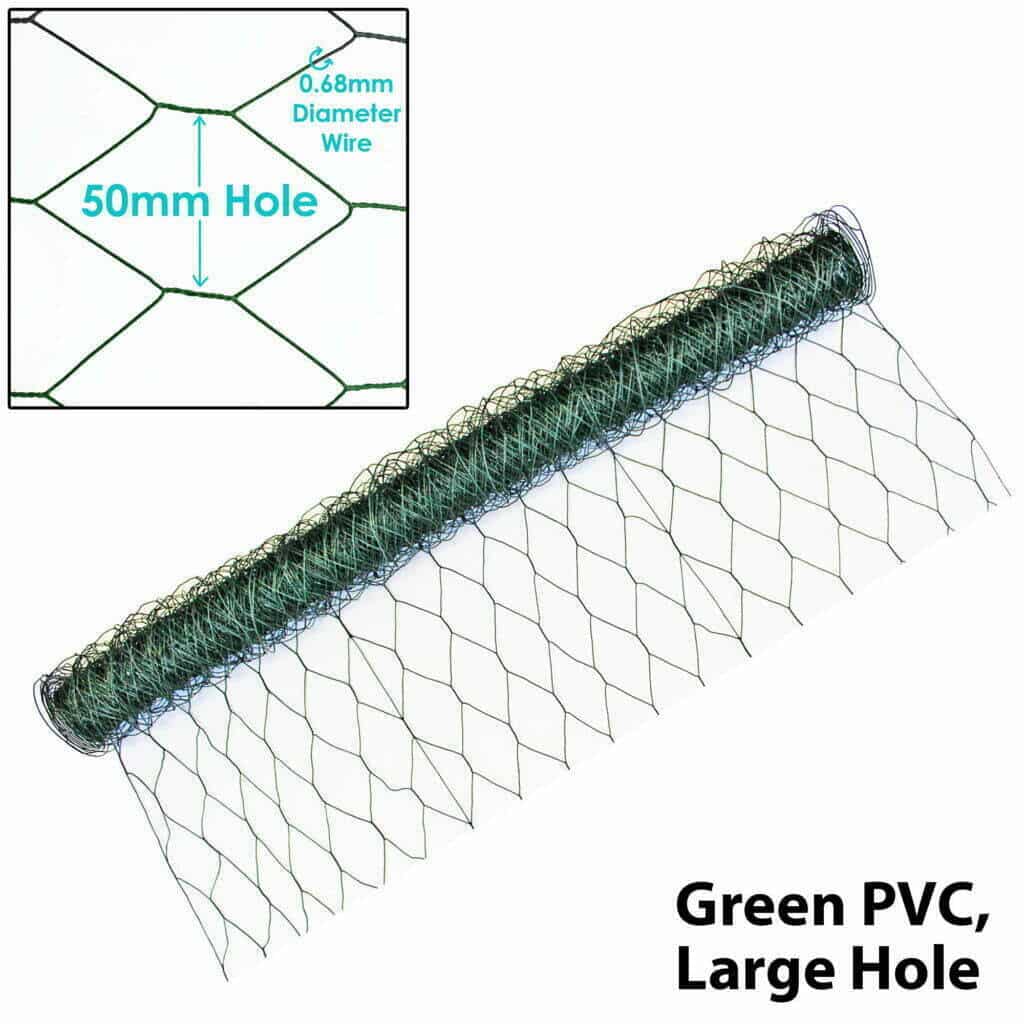
Yes, green PVC coated chicken mesh can be a good option for urban chicken keeping. One of the advantages of using PVC coated chicken mesh is that the green color can blend in with the surroundings, making it less obtrusive and more visually appealing than plain metal wire. This can be especially important in urban or suburban areas where aesthetic considerations are more important.
Another advantage of using PVC coated chicken mesh is that the PVC coating provides protection against rust, corrosion, and weathering, which can help the wire last longer in outdoor environments. Additionally, the PVC coating can help to prevent the wire from scratching or otherwise damaging surfaces, which can be beneficial in urban areas where space is often limited.
When using green PVC coated chicken mesh for urban chicken keeping, it’s important to select a mesh size and wire gauge that is appropriate for the size and type of birds you are housing. It’s also important to ensure that the enclosure is secure and predator-proof, as predators such as raccoons, foxes, and stray dogs can be a problem in urban areas.
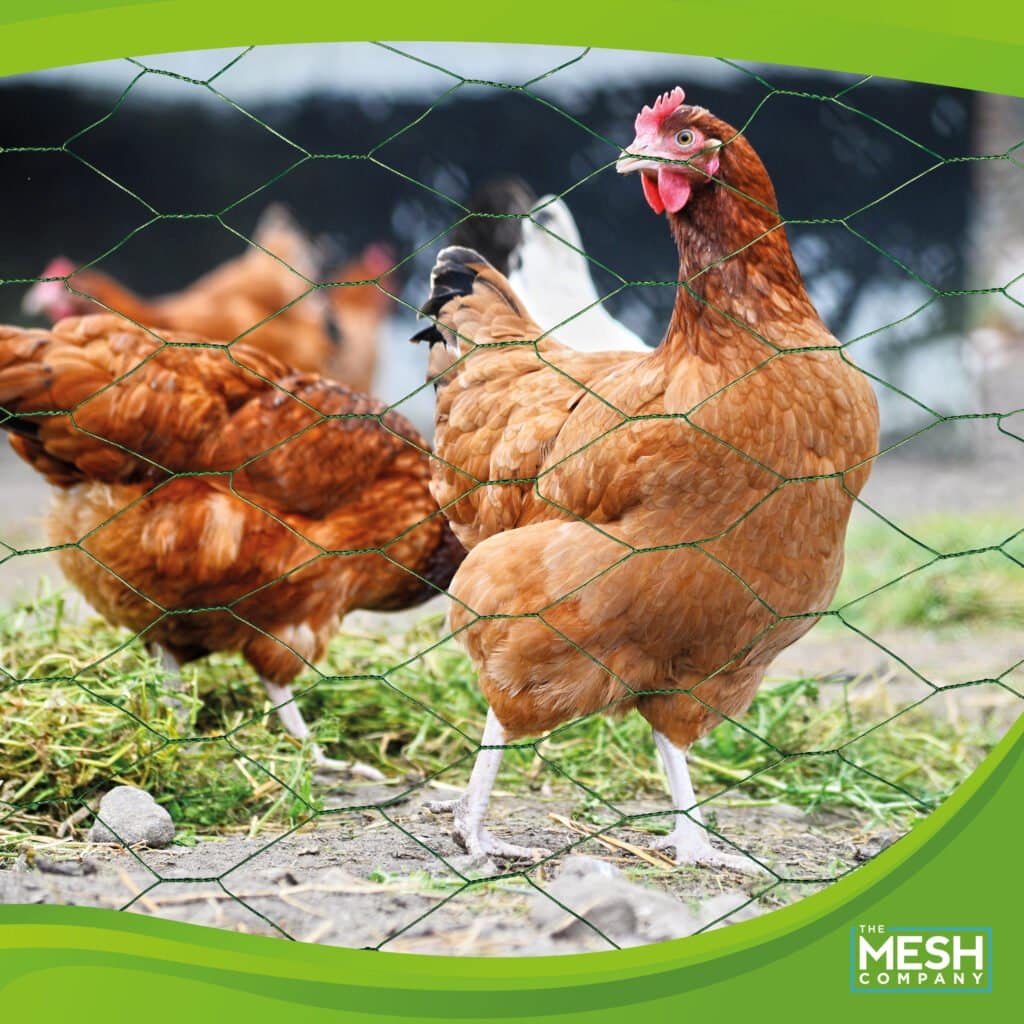
In order to protect green PVC chicken wire from corrosion, rust, and weathering, it is coated with a layer of green PVC plastic. As a result of the PVC coating, the wire blends in with its surroundings, which is beneficial when it comes to landscaping and gardening. The PVC coating can help prevent scratching or other damage to surfaces, making PVC chicken wire easier to handle and install.
Galvanized steel chicken wire, on the other hand, is made of bare metal wire that has been coated with a layer of zinc to protect against rust and corrosion. Galvanized steel chicken wire is generally more durable and long-lasting than PVC chicken wire, and is suitable for outdoor environments where it may be exposed to moisture and other environmental factors. However, the wire may be more visible and less aesthetically pleasing than PVC chicken wire.
While green PVC chicken wire is generally more resistant to damage from the elements than uncoated wire, it is still possible for rabbits and other animals to chew through it. Rabbits have strong teeth and a natural inclination to chew on things, so it’s important to take steps to prevent them from damaging the wire.
One way to prevent rabbits from chewing through green PVC chicken wire is to choose a heavier gauge wire that is more difficult to chew through. A wire gauge of at least 19 or 20 is recommended for chicken runs and other enclosures that are intended to keep rabbits out.
Another option is to use a metal hardware cloth or rodent mesh that is specifically designed to be chew-proof. These types of wire mesh are typically made of steel or other metals that are difficult for rabbits to chew through.
Attaching chicken wire to a brick wall can be done with a few simple steps. Here’s a general guide to help you get started:
Measure the wall: Measure the length and width of the wall to determine the amount of chicken wire needed. Add a few extra inches on each side to allow for overlapping and trimming.
Gather materials: Gather the necessary materials, including chicken wire, wire ties or staples, a hammer or staple gun, and a ladder or step stool.
Cut the chicken wire: Use wire cutters to cut the chicken wire to the desired length and width.
Position the wire: Hold the chicken wire up to the wall and position it in place. Make sure that it is level and straight.
Attach the wire: Use wire ties or staples to attach the chicken wire to the brick wall. For wire ties, wrap the wire around the chicken wire and the brick and twist it tight with pliers. For staples, use a hammer or staple gun to attach the wire to the wall.
Overlap and trim: If necessary, overlap the edges of the chicken wire and attach them with wire ties or staples. Trim any excess wire with wire cutters.
Inspect the attachment: Once you have attached the chicken wire to the wall, inspect the attachment carefully to ensure that it is secure and that there are no gaps or loose areas.
Well, that about covers it. As always, thank you for checking out our blog. We hope that this helps you with your project.
If you do want to learn more about chicken wire then check out our other articles on the subject. We have written in detail on galvanised chicken wire and how to build a chicken coop. Both are very useful reads if you are planning on investing in some wire fencing.
Our goal for our blogs and help guides is to answer as many questions as possible to help to explain the possibilities of mesh to our customers. Contact our team today if you have any questions at all. We are always really keen to help in any way that we can.